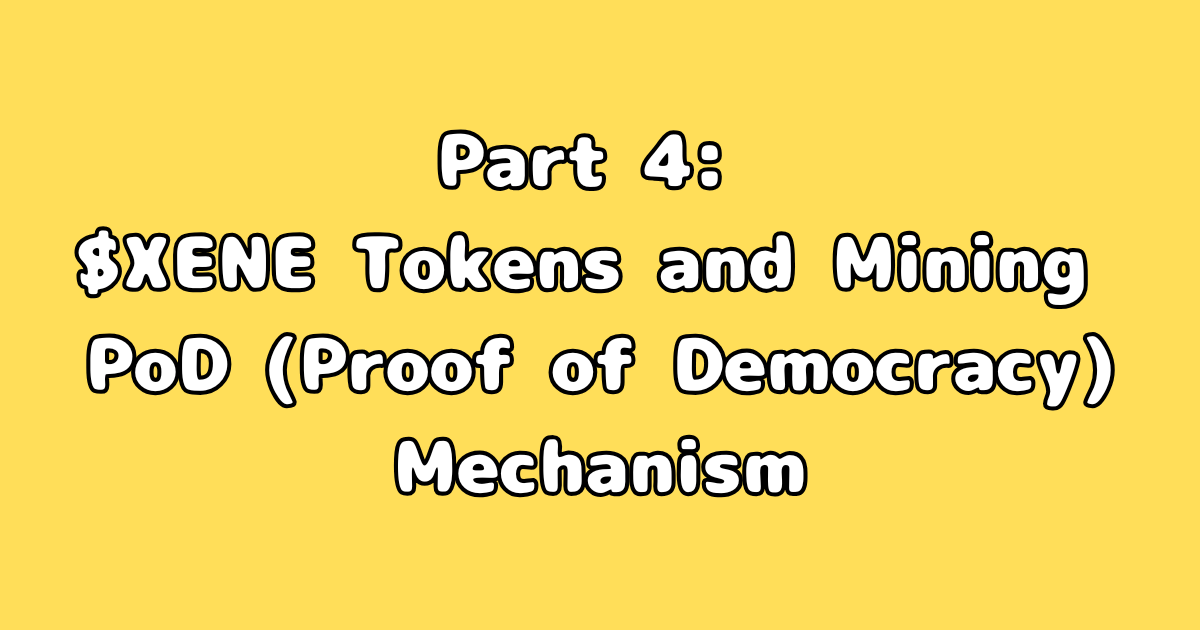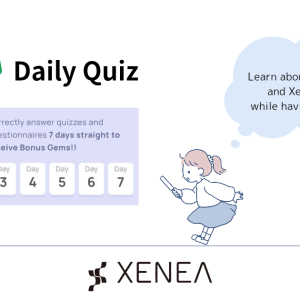Part 4: $XENE Tokens and Mining PoD (Proof of Democracy) Mechanism

In the Xenea ecosystem, the $XENE token serves as the “lifeblood” that powers everything.
However, Xenea’s mining model is based on a unique system called “PoD (Proof of Democracy),” which differs from traditional PoW (Proof of Work) and PoS (Proof of Stake).
This article provides a detailed explanation of the role and acquisition methods of the $XENE token, as well as the innovation behind the democratic PoD mining model.
💰 What is the $XENE Token?
Xenea’s Native Currency
$XENE is the native token of the Xenea blockchain. It officially replaced $XCR during the 2024 rebranding.
Use Cases:
- Payment of transaction fees
- Use and development of decentralized apps (dApps)
- Access fees for DACS (decentralized storage)
- Receipt of mining rewards
- Governance voting (future protocol or parameter changes)
$XENE is designed not just as an asset but as a practical token supporting the operation and growth of the network.
🎯 How Can You Earn $XENE?
1. Earn Gems and Receive $XENE Rewards During TGE
At the Token Generation Event (TGE) scheduled for Q4 2025, gems accumulated in Xenea Wallet will be converted to $XENE based on user contribution.
- Gems ≠ Tokens, but are used as a conversion metric
- User contributions (logins, missions, referrals, etc.) are comprehensively evaluated
- Designed to ensure fair distribution
2. PoD Mining Rewards
After the TGE, users can continue earning $XENE by participating in network maintenance—this is “PoD mining.”
⚙️ What is PoD (Proof of Democracy)?
A New Form of Democratic Mining
PoD stands for “Proof of Democracy,” Xenea’s unique algorithm that forms consensus through voting by a large number of participants. Instead of wealth or computing power, block creation is based on network participation and democratic decision-making.
Comparison with Traditional Models:
| Item | PoW (Bitcoin) | PoS (Ethereum) | PoD (Xenea) |
|---|---|---|---|
| Participation | High-performance machines | Token holdings | Active participation |
| Energy Efficiency | Low | High | High |
| Decentralization | Medium | Low–Medium | High |
| Fairness | Low | Medium | High |
PoD represents the Web3 ideal: a fair network where anyone can participate.
Rep Nodes and Voting-Based Mining
🔹 What is a Rep Node?
Rep (Representative) nodes are nodes that participate in the PoD consensus by receiving delegated voting power from users. While Escrow and Voting nodes handle block approval and transaction validation, Rep nodes act as representatives in the voting process.
🔹 Key Features:
- Users can delegate their voting power to any Rep node via Xenea Wallet
- Rep nodes use delegated power to participate in PoD
- Consensus rewards (block rewards, fees) are shared between Rep nodes and delegating users
🔹 Mining Reward Distribution (as of July 2025):
| Node Type | Reward Share | Function |
|---|---|---|
| Escrow Node | 12% | Final approval of transactions |
| Voting Node | 8% | Vote on transaction validity |
| DACS Node | 80% | Operates decentralized storage (DACS) |
Rep nodes act as Voting nodes and share in the 8% reward pool. Exact reward rates may vary depending on node operators.
🔹 How to Participate in Voting:
- Use Xenea Wallet to select a Rep node and delegate your voting power
- If the delegated node succeeds in PoD, you receive a share of the reward
- You can track voting and reward status in the wallet
✅ How to Become a Node Operator
🔹 Requirements to Join as a Rep Node
To participate in Proof of Democracy (PoD) and earn rewards as a Rep node, you must meet the following:
✅ Participation Requirements (as of July 2025):
- Purchase a Node
- Join the official node sale planned for Q3 2025
- Likely requires XENE tokens (details TBD)
- Prepare an Operational Machine
- Must be always online (PC/server with internet access recommended)
- Early stages will be permissioned (application-based)
- Receive Delegated Votes
- Rep nodes require delegated voting power from users
- More votes = more block approval chances = higher rewards
I’ve posted an article that clearly explains how to register for the XENEA Genesis Node Sale Whitelist, so please use it as a reference.#Xenea #NFT #web3 #NodeSale #limitedhttps://t.co/s5PNT0xMY4
— 節約パパ@Xenea & ChatGPT😃💕 (@setsuyakupapa) August 21, 2025
✅ XENE Token Supply and Value Design
🔹 Total Supply and Inflation Control
$XENE is not an unlimited token—it has a maximum supply of 1,832,810,964 XENE, designed to maintain sustainable network operations and long-term token value.
- Genesis Block Issuance: 1,201,658,964 XENE
- Mining Rewards Allocation: 631,152,000 XENE
- Once the total cap is reached, no further issuance will occur
Additionally, $XENE implements halving every two years to control long-term emission pace.
🔹 Token Circulation Structure
$XENE flows through the network and supports the ecosystem in the following ways:
- Distributed as Rewards
- Mining rewards for Escrow, Voting, and DACS nodes
- Indirect distribution to Rep nodes and delegating users
- Used for Fees
- Transaction fees, DACS storage usage, etc.
- Burn Mechanism (Unconfirmed)
- While some documents mention this, no official confirmation exists regarding a burn mechanism for $XENE
🔹 Future Use Cases and Value Expansion
Beyond being a reward token, $XENE is expected to expand into the following uses:
- DACS storage fees (pay-per-use model)
- Governance voting on protocol changes
- Cross-chain bridge transaction fees
- QR code or contactless payments in physical stores
- Staking and rewards from node operations
Xenea Wallet is designed as a utility app that integrates all of these functions, combining $XENE’s practicality with its asset value.
Conclusion: A Future-Oriented Mining Model Where Participation Builds Wealth
Xenea’s “Proof of Democracy” represents a revolutionary system enabling fair and accessible mining for everyone. Whether it’s accumulating gems, voting, or running a node, each action transforms into $XENE—your growing digital asset.
Next (Part 5), we’ll dive into “Xenea’s patented technologies and security“, explaining how your assets are protected both technically and legally.


Comment